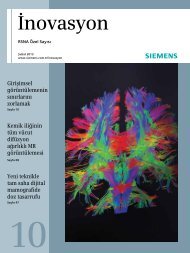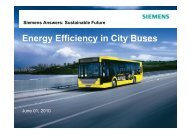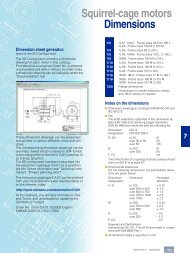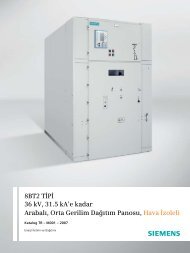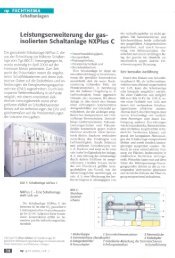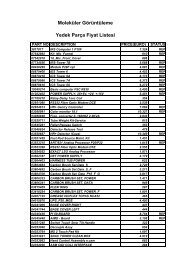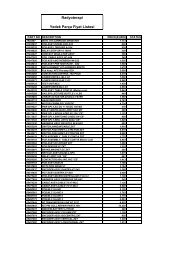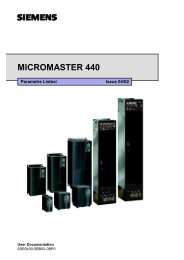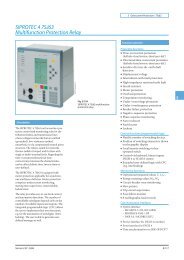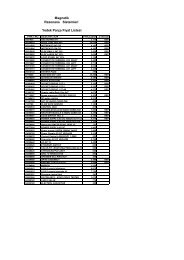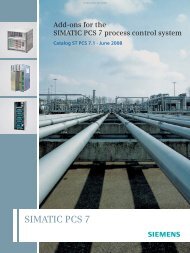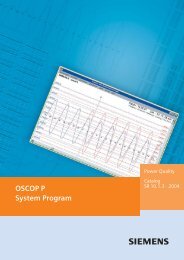Building automation â impact on energy efficiency - Siemens ...
Building automation â impact on energy efficiency - Siemens ...
Building automation â impact on energy efficiency - Siemens ...
You also want an ePaper? Increase the reach of your titles
YUMPU automatically turns print PDFs into web optimized ePapers that Google loves.
5.2 Customer benefits resulting from<br />
eu.bac Cert<br />
For the product user, eu.bac Cert guarantees a high-degree of<br />
• <strong>energy</strong> <strong>efficiency</strong> and<br />
• product quality<br />
as set forth in the corresp<strong>on</strong>ding EN / ISO standards and European Directives.<br />
The <strong>energy</strong> <strong>efficiency</strong> of individual room c<strong>on</strong>trollers can be documented as follows:<br />
Impact <strong>on</strong> <strong>energy</strong> savings<br />
As menti<strong>on</strong>ed earlier, the c<strong>on</strong>trol accuracy of individual room c<strong>on</strong>trollers is<br />
measured and c<strong>on</strong>firmed with a certificate. The c<strong>on</strong>trol accuracy has a direct<br />
<str<strong>on</strong>g>impact</str<strong>on</strong>g> <strong>on</strong> the behavior of room users. The poorer the c<strong>on</strong>trol accuracy, the<br />
more likely the user is to adjust the room setpoint as a result of poor comfort.<br />
The chart below illustrates how much <strong>energy</strong> (in %) a c<strong>on</strong>troller with c<strong>on</strong>trol accuracy<br />
of 0.2 K saves versus a c<strong>on</strong>troller with c<strong>on</strong>trol accuracy of 1.4 K. Please<br />
note the following:<br />
Eu.bac has reduced the required minimum c<strong>on</strong>trol accuracy in EN15500 from 2<br />
K to 1.4 K.<br />
Source: "Centre Scientifique et Technique du Bâtiment (CSTB)", France<br />
<strong>Siemens</strong> individual room c<strong>on</strong>trollers achieved very solid values. For example,<br />
for Desigo RXC21/fan coil with actuators for heating 0.2 K and cooling 0.1 K.<br />
Impact of actuator <strong>on</strong><br />
<strong>energy</strong> savings<br />
It is well known that characteristics (time c<strong>on</strong>stants, adjustment resp<strong>on</strong>se, characteristic<br />
curve, etc.) for field devices have a direct <str<strong>on</strong>g>impact</str<strong>on</strong>g> <strong>on</strong> c<strong>on</strong>trol accuracy.<br />
In other words, we achieve different levels of c<strong>on</strong>trol accuracy with the same individual<br />
room c<strong>on</strong>trollers and temperature sensors, but using different valve actuators<br />
(motor, thermal modulating, thermal <strong>on</strong>/off) and thus different <strong>energy</strong><br />
savings. On the flip side, the variously equipped c<strong>on</strong>trol circuits cause differences<br />
in the costs of the c<strong>on</strong>trol circuit.<br />
The chart below illustrates that a higher investment in motor driven valves<br />
makes sense versus thermally driven valves (in the comparis<strong>on</strong> with the previous<br />
chart, curve "natural gas heating H3"/Southern France):<br />
• The amortizati<strong>on</strong> period for the investment is shorter<br />
• Then operating costs are lower as a result of larger <strong>energy</strong> savings<br />
• And the <str<strong>on</strong>g>impact</str<strong>on</strong>g> <strong>on</strong> the envir<strong>on</strong>ment declines in line with the <strong>energy</strong> savings<br />
104



